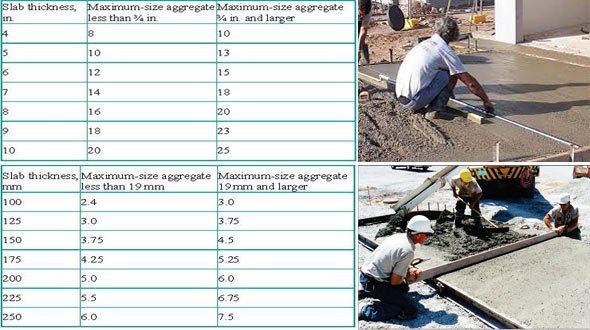Benefits of arranging joints in concrete flatwork
- Concrete Cost Estimator
- Concrete Continuous Footing
- Landscape Bidding and Estimating
- Construction Cost Estimating
- Concrete and steel cost estimation
- Construction Cost Estimate Breakdown
- Construction Estimating Worksheet
- Home Construction Cost Estimate
- Estimate Pricing Sheet
- Sheet for General Contractor
- Construction Cost Estimate
- Labor Materials Cost Estimator
- Masonry Estimating Sheet
- Sheet for Building Contractor
- Construction Schedule Bar chart
- General Cost Estimator Sheet
- General Construction Estimate
- Building and Road Estimating Sheet
- Detailed expense estimates
- Door and Window Takeoff Sheet
- General Construction Cost Estimating Sheet

Contraction/control joints are mainly provided in concrete slabs to deal with random cracking. A fresh concrete mixture belongs to a fluid, plastic mass that is molded into virtually any figure, but due to solidification, a decline in volume or shrinkage occurs.
When shrinkage is controlled with different factors like supporting soils, granular fill, adjacent structures, or reinforcement inside the concrete, tensile stresses are produced inside the concrete section.
The concrete has good strength in compression but the tensile strength remains only 8 to 12 percent of the compressive strength. In fact, tensile stresses operate against the feeble property of the concrete material. It leads to cracking of the concrete.
There exist two basic strategies to manage cracking for good overall structural behavior. One method is to arrange steel reinforcement in the slab for retaining random cracks firmly. If cracks are retained firmly or persist small, the aggregate particles on the faces of a crack are interlaced and as a result the load is transmitted across the crack. It should be kept in mind that when steel reinforcement in a concrete slab is applied, the arbitrary hairline cracks may occur in the uncovered surface of the concrete.
The most accepted process to manage random cracking in concrete slabs is to arrange contraction/control joints in the concrete surface at prearranged locations to produce weakened planes where the cracking of concrete will be in a straight line. It creates an elegantly attractive look as the crack happens underneath the finished concrete surface. The non-existence of random cracks at the concrete surface gives the look of an un-cracked section.
Concrete slabs-on-ground have constantly good performance when the following considerations are solicited. The soils or granular fill which provide support to the slab in service should be either undisturbed soil or well compacted. Besides, contraction joints should be arranged to produce panels to be as square as possible and never surpass a length to width ratio of 1.5 to 1. Joints are usually spanned at distances equivalent to 24 to 30 times the slab thickness. Joint spacing that is in excess of 15 feet needs the application of load transfer devices like dowels or diamond plates.
While placing, contraction joints may be tooled into the concrete surface. Joints may be tooled into the surface (first pass) before the onset of bleeding or right away with the first pass of the floating operation. If the first pass for jointing is detained for a long time, the process will be more complicated to form clean straight line joints. Tooled joints should be reconstituted with every succeeding pass of finishing operations.
Joints may also be sawed into the hardened concrete surface. It is important to understand that the longer sawing is delayed the higher the potential for cracks to establish themselves before sawing is complete. This means that any cracks that occur before the concrete is sawed will render the sawed joint ineffective. Timing is very important. Joints should be sawed once the concrete will resist the energy of sawing devoid of raveling or displacing aggregate particles. For various concrete mixtures, the task of sawing should be finished within the first six to 18 hours and never deferred over 24 hours. Early-entry saws are accessible which may facilitate cutting to be commenced within a few hours following placement.
Contraction/control joints should be set up to a depth of ¼ the slab thickness. There should be perfect joint spacing and depth to manage random cracking efficiently.

- Application of concrete calculator
- Roofing Calculator can streamline the roof estimating process
- House construction cost calculator
- Engineering column design excel spreadsheet
- Material Estimating Sheet with Excel
- Materials List and Cost Estimate Worksheet
- Concrete Slab Estimating Calculator Sheet
- Common types of foundations for buildings
- Online calculation of construction materials
- Estimating with Excel for the Small Contractor
- Concrete Beam Design Spreadsheet
- Virtual Construction Management app for construction
- Autodesk’s Project Skyscraper
- Reed Construction’s Reed Insight
- Manage your construction project documentation
- Costimator, the popular cost estimating software
- On Center Software for construction professionals
- Free Construction Estimating Software
- Plumbing Calc Pro
- Cost Estimate Worksheet
- HVAC Piping Quantity Takeoff Worksheet
- Construction Estimating Software Sheet
- Estimate Cost Templates
- Construction Punch List
- Construction cost estimating template consisting estimating basic
- Gantt Chart Template for Excel
- Download Civil Engineering Spreadsheets with Verification
- The Building Advisor Estimating and Budgeting Worksheet
- Spreadsheet for design of concrete bridge
- Construction Estimating Software Free








